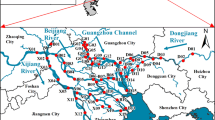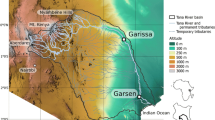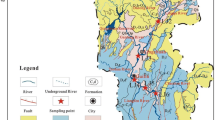Abstract
Riverine transport of dissolved inorganic carbon (DIC) from land to the ocean is an important carbon flux that influences the carbon budget at the watershed scale. However, the dynamics of DIC in an entire river network has remained unknown, especially in mountainous Japanese watersheds. We examined the effects of watershed land use and geology on the transports of inorganic carbon as well as weathered silica (Si) and calcium (Ca) in the Iwaki River system where agricultural and residential areas have developed in the middle and lower parts of the watershed. The concentration and stable carbon isotope ratios (δ13C) of DIC showed the longitudinal increase of 13C-depleted inorganic carbon along the river. As a result, most streams and rivers were supersaturated in dissolved CO2 that will eventually be emitted to the atmosphere. The possible origin of 13C-depleted carbon is CO2 derived from the decomposition of organic matter in agricultural and urban landscapes, as well as from in-stream respiration. In addition, agricultural and urban areas, respectively, exported the large amount of dissolved Si and Ca to the rivers, suggesting that CO2 increased by respiration accelerates the chemical weathering of silicate and carbonate materials in soils, river sediments, and/or urban infrastructure. Furthermore, riverine bicarbonate flux is likely to enter shell carbonates of Corbicula japonica, an aragonitic bivalve, in the downstream brackish lake (Lake Jusan). These results revealed that the flux of DIC from the human-dominated watersheds is a key to understanding the carbon dynamics and food-web structure along the land-to-river-to-ocean continuum.





Similar content being viewed by others
References
Alexander RB, Smith RA, Schwarz GE (2000) Effect of stream channel size on the delivery of nitrogen to the Gulf of Mexico. Nature 403:758–761
Aucour A-M, Sheppard SMF, Guyomar O, Wattelet J (1999) Use of 13C to trace origin and cycling of inorganic carbon in the Rhône river system. Chem Geol 159:87–105
Aucour A-M, Sheppard SMF, Savoye R (2003) δ13C of fluvial mollusk shells (Rhône River): a proxy for dissolved inorganic carbon? Limnol Oceanogr 48:2186–2193
Barnes R, Raymond PA (2009) The contribution of agricultural and urban activities to inorganic carbon fluxes within temperate watersheds. Chem Geol 266:318–327
Bernard CY, Dürr HH, Heinze C, Segschneider J, Maier-Reimer E (2011) Contribution of riverine nutrients to the silicon biogeochemistry of the global ocean—a modal study. Biogeosciences 8:551–564
Berner RA, Lasaga AC, Garrels RM (1983) The carbonate–silicate geochemical cycle and its effect on atmospheric carbon dioxide over the past 100 million years. Am J Sci 283:641–683
Bluth GJS, Kump LR (1994) Lithologic and climatologic controls of river chemistry. Geochim Cosmochim Acta 58:2341–2359
Boyd PW, Law CS, Wong CS, Nojiri Y, Tsuda A, Levasseur M, Takeda S, Rivkin R, Harrison PJ, Strzepek R, Gower J, McKay RM, Abraham E, Arychuk M, Barwell-Clarke J, Crawford W, Crawford D, Hale M, Harada K, Johnson K, Kiyosawa H, Kudo I, Marchetti A, Miller W, Needoba J, Nishioka J, Ogawa H, Page J, Robert M, Saito H, Sastri A, Sherry N, Soutar T, Sutherland N, Taira Y, Whitney F, Emmy Wong S-K, Yoshimura T (2004) The decline and fate of an iron-induced subarctic phytoplankton bloom. Nature 428:549–553
Butman D, Raymond PA (2011) Significant efflux of carbon dioxide from streams and rivers in the United States. Nat Geosci 4:839–842
Cerling TE, Solomon DK, Quade J, Bowman JR (1991) On the isotopic composition of carbon in soil carbon dioxide. Geochim Cosmochim Acta 55:3403–3405
Cole JJ, Caraco NF (2001) Carbon in catchments: connecting terrestrial carbon losses with aquatic metabolism. Mar Freshw Res 52:101–110
Cole JJ, Caraco NF, Kling GW, Kratz TK (1994) Carbon dioxide supersaturation in the surface waters of lakes. Science 265:1568–1570
Cole JJ, Prairie YT, Caraco NF, McDowell WH, Tranvik LJ, Striegl RG, Duarte CM, Kortelainen P, Downing JA, Middleburg J, Melack J (2007) Plumbing the global carbon cycle: integrating inland waters into the terrestrial carbon budget. Ecosystems 10:171–184
Denman KL, Brasseur G, Chidthaisong A, Ciais P, Cox PM, Dickinson RE, Hauglustaine D, Heinze C, Holland E, Jacob D, Lohmann U, Ramachandran S, da Silva Dias PL, Wofsy SC, Zhang X (2007) Couplings between changes in the climate system and biogeochemistry. In: Solomon S, Qin D, Manning M, Chen Z, Marquis M, Averyt KB, Tignor M, Miller HL (eds) Climate change 2007: the physical science basis. Contribution of Working Group I to the Fourth Assessment Report of the Intergovernmental Panel on Climate Change. Cambridge University Press, Cambridge
DOE (1994) Handbook of methods for the analysis of the various parameters of the carbon dioxide system in sea water; version 2. ORNL/CDIAC-74, Oak Ridge
Dubois KD, Lee D, Veizer J (2010) Isotopic constraints on alkalinity, dissolved organic carbon, and atmospheric carbon dioxide fluxes in the Mississippi River. J Geophys Res 115:G02018
Dürr HH, Meybeck M, Hartmann J, Laruelle GG, Roubeix V (2011) Global spatial distribution of natural riverine silica inputs to the coastal zone. Biogeosciences 6:1345–1401
Finlay JC (2003) Controls of streamwater dissolved organic carbon dynamics in a forested watershed. Biogeochemistry 62:231–252
Frankignoulle M, Abril G, Borges A, Bourge I, Canon C, Delille B, Libert E, Théate J-M (1998) Carbon dioxide emission from European estuaries. Science 282:434–436
Gattuso J-P, Frankignoulle M, Wollast R (1998) Carbon and carbonate metabolism in coastal aquatic ecosystems. Annu Rev Ecol Syst 29:405–434
Griffith DR, Barnes RT, Raymond PA (2009) Input of fossil carbon from wastewater treatment plants to U.S. rivers and oceans. Environ Sci Technol 43:5647–5651
Hamilton SK, Kurzman AL, Arango C, Jin L, Robertson GP (2007) Evidence for carbon sequestration by agricultural liming. Global Biogeochem Cycles 21:GB2021
Hartmann J (2009) Bicarbonate-fluxes and CO2-consumption by chemical weathering on the Japanese Archipelago—application of a multi-lithological model framework. Chem Geol 265:237–271
Hartmann J, Jansen N, Dürr HH, Harashima A, Okubo K, Kempe S (2010) Predicting riverine dissolved silica fluxes to coastal zones from a hyperactive region and analysis of their first-order controls. Int J Earth Sci 99:207–230
Humborg C, Conley DJ, Rahm L, Wulff F, Cociasu A, Ittekkot V (2000) Silicon retention in river basins: far-reaching effects on biogeochemistry and aquatic food webs in coastal marine environments. Ambio 29:45–50
Kasai A, Toyohara H, Nakata A, Miura T, Azuma N (2006) Food sources for the bivalve Corbicula japonica in the foremost fishing lakes estimated from stable isotope analysis. Fish Sci 72:105–114
Kling GW, Kipphut GW, Miller MC (1991) Arctic lakes and streams as gas conduits to the atmosphere: implications for tundra carbon budgets. Science 251:298–301
Leopold LB, Wolman MG, Miller JP (1964) Fluvial processes in geomorphology. Dover Publications, New York
Ludwig W, Probst J-L, Kempe S (1996) Predicting the oceanic input of organic carbon by continental erosion. Global Biogeochem Cycles 10:23–41
Martin JH, Fitzwater SE (1988) Iron deficiency limits phytoplankton growth in the north-east Pacific subarctic. Nature 331:341–343
McConnaughey TA, Gillikin DP (2008) Carbon isotopes in mollusk shell carbonates. Geo Mar Lett 28:287–299
Meybeck M, Dürr HH, Vörösmarty CJ (2006) Global coastal segmentation and its river catchment contributors: a new tool at land–ocean linkage. Global Biogeochem Cycles 20:GB1S90
Minoura K, Nakaya S (1990) Origin of inter-tidal lake and marsh environments in and around Lake Jusan, Tsugaru. Mem Geol Soc Japan 36:71–87
Miyajima T, Yamada Y, Hanba YT, Yoshii K, Koitabashi T, Wada E (1995) Determining the stable isotope ratio of total dissolved inorganic carbon in lake water by GC/C/IRMS. Limnol Oceanogr 40:994–1000
Mook WG, Bommerson JC, Staverman WH (1974) Carbon isotope fractionation between dissolved bicarbonate and gaseous carbon dioxide. Earth Planet Sci Lett 22:169–176
Nakano T, Tayasu I, Yamada Y, Hosono T, Igeta A, Hyodo F, Ando A, Saitoh Y, Tanaka T, Wada E, Yachi S (2008) Effect of agriculture on water quality of Lake Biwa tributaries, Japan. Sci Total Environ 389:132–148
Oh N-H, Raymond PA (2006) Contribution of agricultural liming to riverine bicarbonate export and CO2 sequestration in the Ohio River basin. Global Biogeochem Cycles 20:GB3012
Ohte N, Tokuchi N (1999) Geographical variation of the acid buffering of vegetated catchments: factors determining the bicarbonate leaching. Global Biogeochem Cycles 13:969–996
Raymond PA, Cole JJ (2003) Increase in the export of alkalinity from North America’s largest river. Science 301:88–91
Richey JE, Melack JM, Aufdenkampe AK, Ballester VM, Hess LL (2002) Outgassing from Amazonian rivers and wetlands as a large tropical source of atmospheric CO2. Science 416:617–620
Rodríguez-Navarro C, Sebastián E, Rodríguez-Gallego M (1997) An urban model for dolomite precipitation: authigenic dolomite on weathered building stones. Sediment Geol 109:1–11
Romanek CS, Grossman EL, Morse JW (1992) Carbon isotopic fractionation in synthetic aragonite and calcite: effects of temperature and precipitation rate. Geochim Cosmochim Acta 56:419–430
Rose A, Waite D (2003) Kinetics of iron complexation by dissolved natural organic matter in coastal waters. Mar Chem 84:85–103
Schlesinger WH, Melack JM (1981) Transport of organic carbon in the world’s rivers. Tellus 33:172–187
Smith RA, Schwarz GE, Alexander RB (1997) Regional interpretation of water-quality monitoring data. Wat Resour Res 33:2781–2798
Sobczak WV, Cloern JE, Jassby AD, Müler-Solger AB (2002) Bioavailability of organic matter in a highly disturbed estuary: the role of detrital and algal resources. Proc Natl Acad Sci USA 99:8101–8105
Sobek S, Algesten G, Bergström A-K, Jansson M, Tranvik LJ (2003) The catchment and climate regulation of pCO2 in boreal lakes. Global Change Biol 9:630–641
Stumm W, Morgan JJ (1996) Aquatic chemistry: chemical equilibria and rates in natural waters, 3rd edn. Wiley, New York
Umitsu M (1976) Geomorphic development of the Tsugaru Plain in the Holocene period. Geogr Rev Japan 49:714–735
West TO, McBride AC (2005) The contribution of agricultural lime to carbon dioxide emissions in the United States: dissolution, transport, and net emissions. Agric Ecosyst Environ 108:145–154
Zeebe RE, Wolf-Gladrow D (2003) CO2 in seawater: equilibrium, kinetics, isotopes. Elsevier, Amsterdam
Zeng FW, Masiello CA, Hockaday WC (2011) Controls on the origin and cycling of riverine dissolved inorganic carbon in the Brazos River, Texas. Biogeochemistry 104:275–291
Acknowledgments
We thank M. Sasaki, N. Azuma, H. Watanabe, M. Yoshimura, D. Naito, Y. Horikawa, M. Itoh, and the Aomori Office of River and National Highway for their support to our study. The stable isotope analysis was conducted using Cooperative Research Facilities (Isotope Ratio Mass Spectrometer) at the Center for Ecological Research, Kyoto University. The study was fulfilled as a part of the tasks of the Iwaki River Research Group, and was supported financially by the Foundation for Riverfront Improvement and Restoration and partly by the Environment Research and Technology Development Fund (D-1002) of the Ministry of the Environment, Japan to JU.
Author information
Authors and Affiliations
Corresponding author
Electronic supplementary material
Below is the link to the electronic supplementary material.
About this article
Cite this article
Iwata, T., Suzuki, T., Togashi, H. et al. Fluvial transport of carbon along the river-to-ocean continuum and its potential impacts on a brackish water food web in the Iwaki River watershed, northern Japan. Ecol Res 28, 703–716 (2013). https://doi.org/10.1007/s11284-013-1047-8
Received:
Accepted:
Published:
Issue Date:
DOI: https://doi.org/10.1007/s11284-013-1047-8




